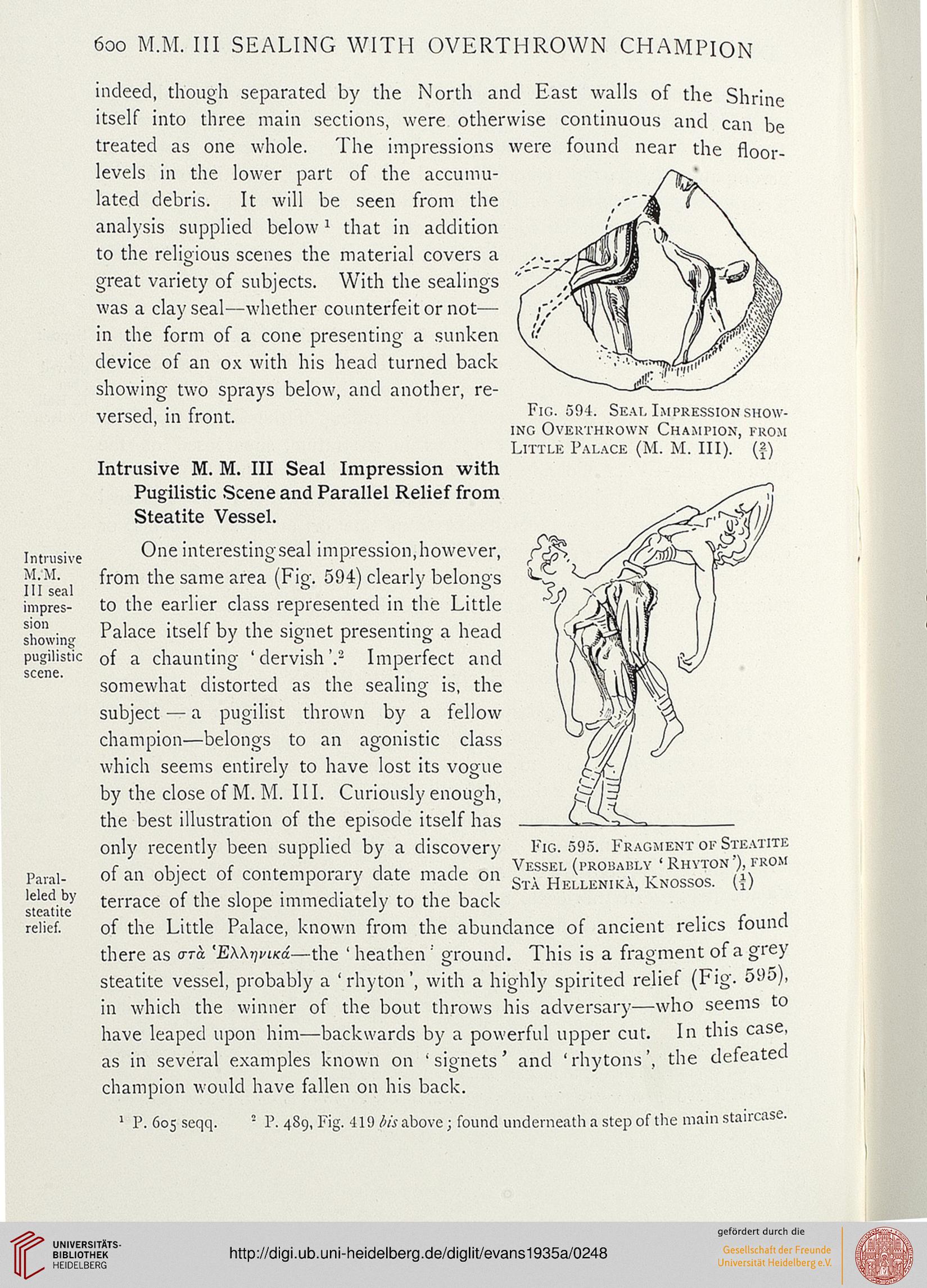6oo M.M. Ill SEALING WITH OVERTHROWN CHAMPION
indeed, though separated by the North and East walls of the Shrine
itself into three main sections, were otherwise continuous and can be
treated as one whole. The impressions
levels in the lower part of the accumu-
lated debris. It will be seen from the
analysis supplied below> that in addition
to the religious scenes the material covers a
great variety of subjects. With the sealings
was a clay seal—whether counterfeit or not—
in the form of a cone presenting a sunken
device of an ox with his head turned back
showing two sprays below, and another, re-
versed, in front.
Intrusive M. M. Ill Seal Impression with
Pugilistic Scene and Parallel Relief from
Steatite Vessel.
Intrusive
M.M.
Ill seal
impres-
sion
showing
pugilistic
scene.
Paral-
leled by
steatite
relief.
were found near
Fig. 594. Seat. Impression show-
ing Overthrown Champion, from
Little Palace (M. M. Ill), (f)
One interestingseal impression,however,
from the same area (Fig. 594) clearly belongs
to the earlier class represented in the Little
Palace itself by the signet presenting a head
of a chaunting 'dervish'.2 Imperfect and
somewhat distorted as the sealing is, the
subject — a pugilist thrown by a fellow
champion—belongs to an agonistic class
which seems entirely to have lost its vogue
by the close of M. M. III. Curiously enough,
the best illustration of the episode itself has
only recently been supplied by a discovery
of an object of contemporary date made on
terrace of the slope immediately to the back
of the Little Palace, known from the abundance of ancient relics found
there as era 'EAXipi/ta—the ' heathen' ground. This is a fragment of a grey
steatite vessel, probably a 'rhyton', with a highly spirited relief (Fig. 59o),
in which the winner of the bout throws his adversary—who seems to
have leaped upon him—backwards by a powerful upper cut. In this case,
as in several examples known on 'signets' and 'rhytons', the defeated
champion would have fallen on his back.
1 P. 605 seqq. " P. 489, Fig. 419 Us above; found underneath a step of the main staircase.
Fig. 595. Fragment or Steatite
Vessel (probably ' Rhyton '), from
Sta Hellenika, Knossos. (J)
indeed, though separated by the North and East walls of the Shrine
itself into three main sections, were otherwise continuous and can be
treated as one whole. The impressions
levels in the lower part of the accumu-
lated debris. It will be seen from the
analysis supplied below> that in addition
to the religious scenes the material covers a
great variety of subjects. With the sealings
was a clay seal—whether counterfeit or not—
in the form of a cone presenting a sunken
device of an ox with his head turned back
showing two sprays below, and another, re-
versed, in front.
Intrusive M. M. Ill Seal Impression with
Pugilistic Scene and Parallel Relief from
Steatite Vessel.
Intrusive
M.M.
Ill seal
impres-
sion
showing
pugilistic
scene.
Paral-
leled by
steatite
relief.
were found near
Fig. 594. Seat. Impression show-
ing Overthrown Champion, from
Little Palace (M. M. Ill), (f)
One interestingseal impression,however,
from the same area (Fig. 594) clearly belongs
to the earlier class represented in the Little
Palace itself by the signet presenting a head
of a chaunting 'dervish'.2 Imperfect and
somewhat distorted as the sealing is, the
subject — a pugilist thrown by a fellow
champion—belongs to an agonistic class
which seems entirely to have lost its vogue
by the close of M. M. III. Curiously enough,
the best illustration of the episode itself has
only recently been supplied by a discovery
of an object of contemporary date made on
terrace of the slope immediately to the back
of the Little Palace, known from the abundance of ancient relics found
there as era 'EAXipi/ta—the ' heathen' ground. This is a fragment of a grey
steatite vessel, probably a 'rhyton', with a highly spirited relief (Fig. 59o),
in which the winner of the bout throws his adversary—who seems to
have leaped upon him—backwards by a powerful upper cut. In this case,
as in several examples known on 'signets' and 'rhytons', the defeated
champion would have fallen on his back.
1 P. 605 seqq. " P. 489, Fig. 419 Us above; found underneath a step of the main staircase.
Fig. 595. Fragment or Steatite
Vessel (probably ' Rhyton '), from
Sta Hellenika, Knossos. (J)




